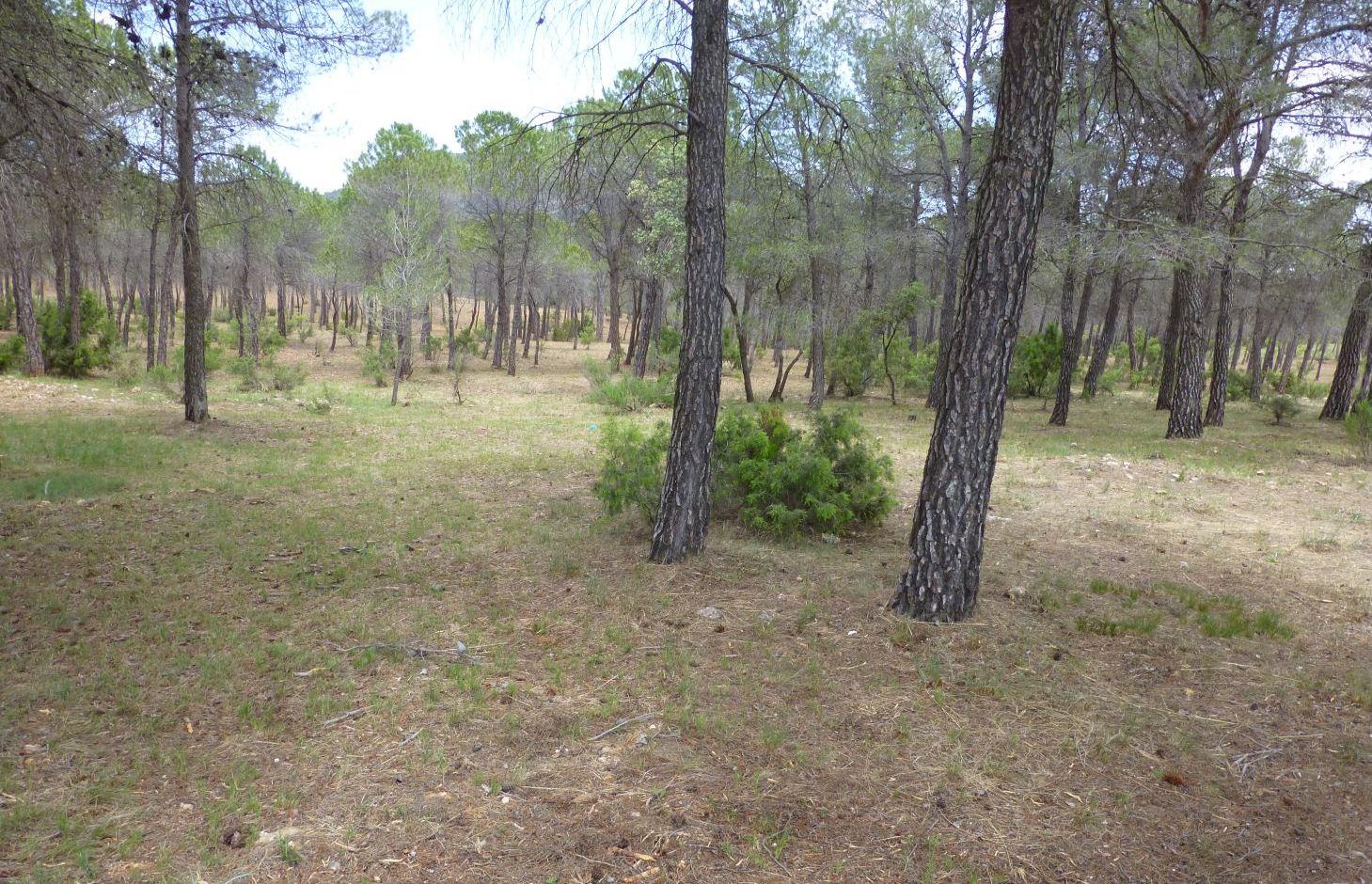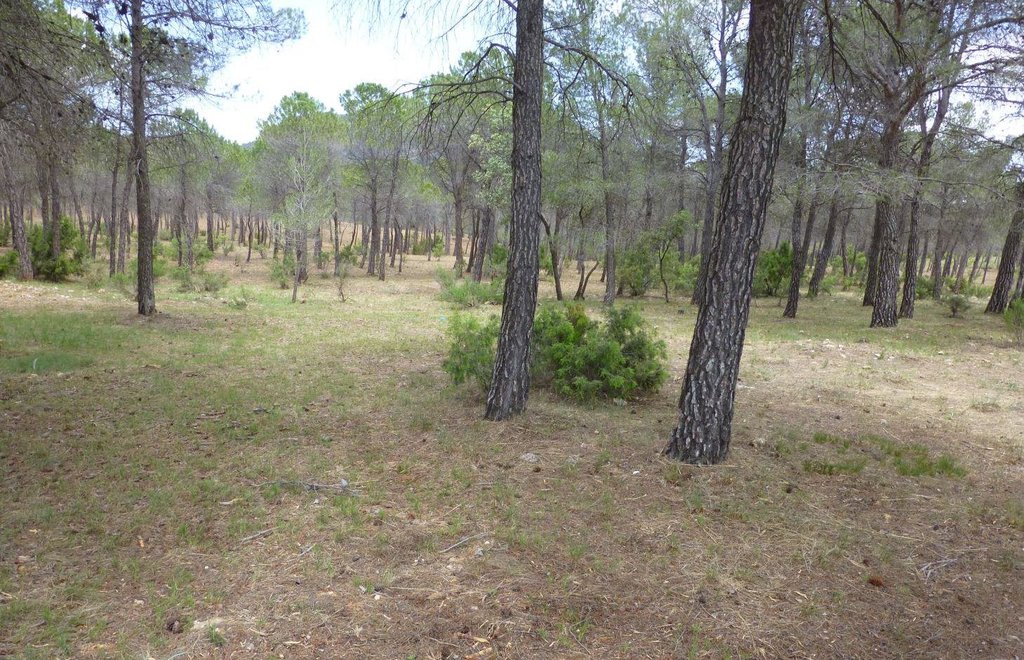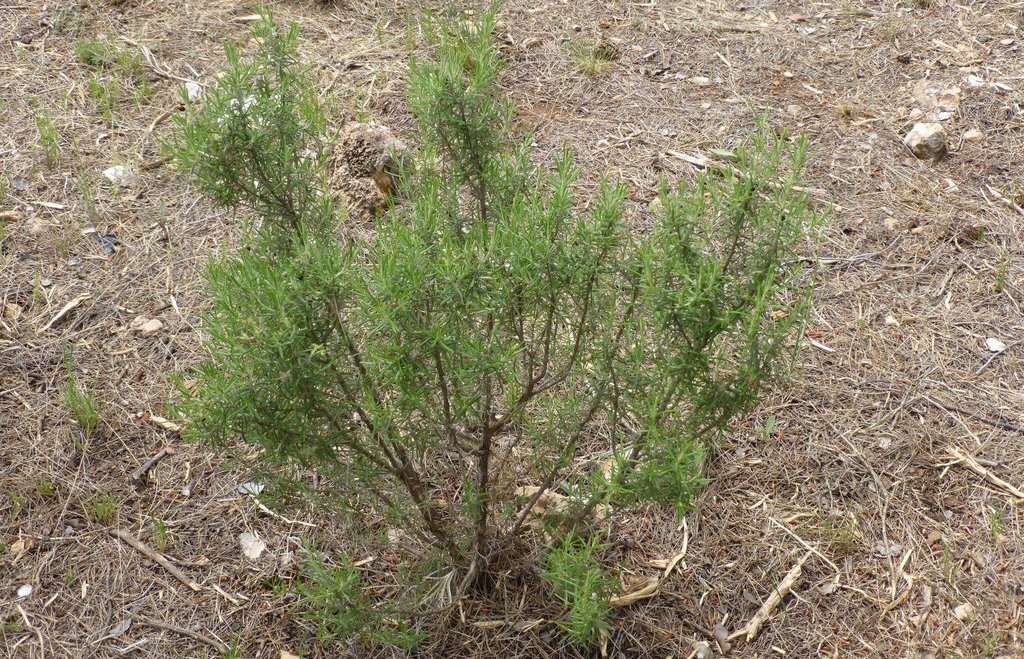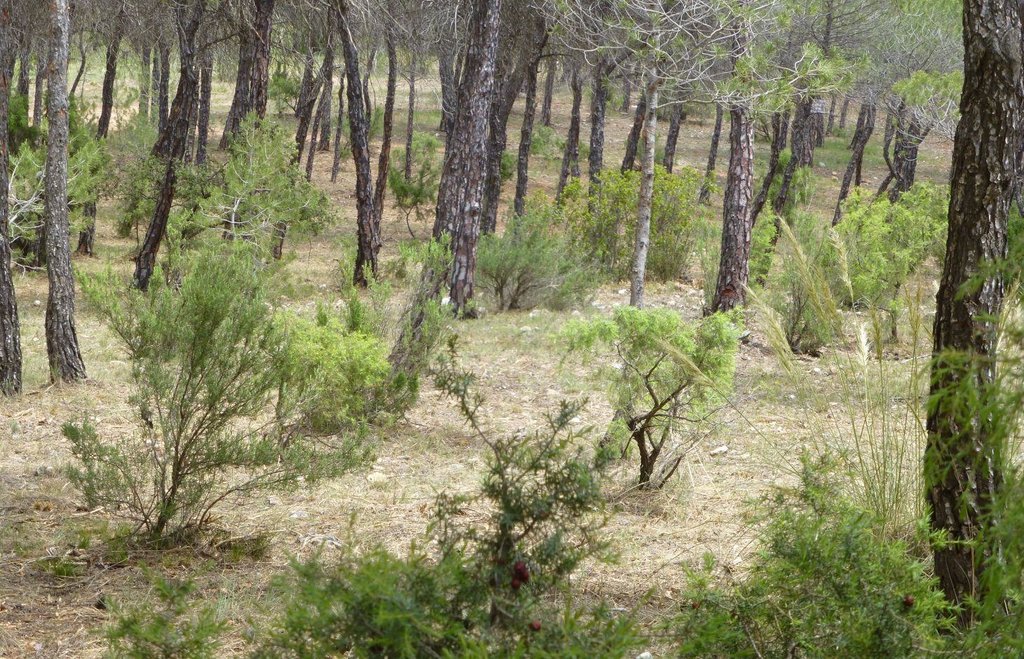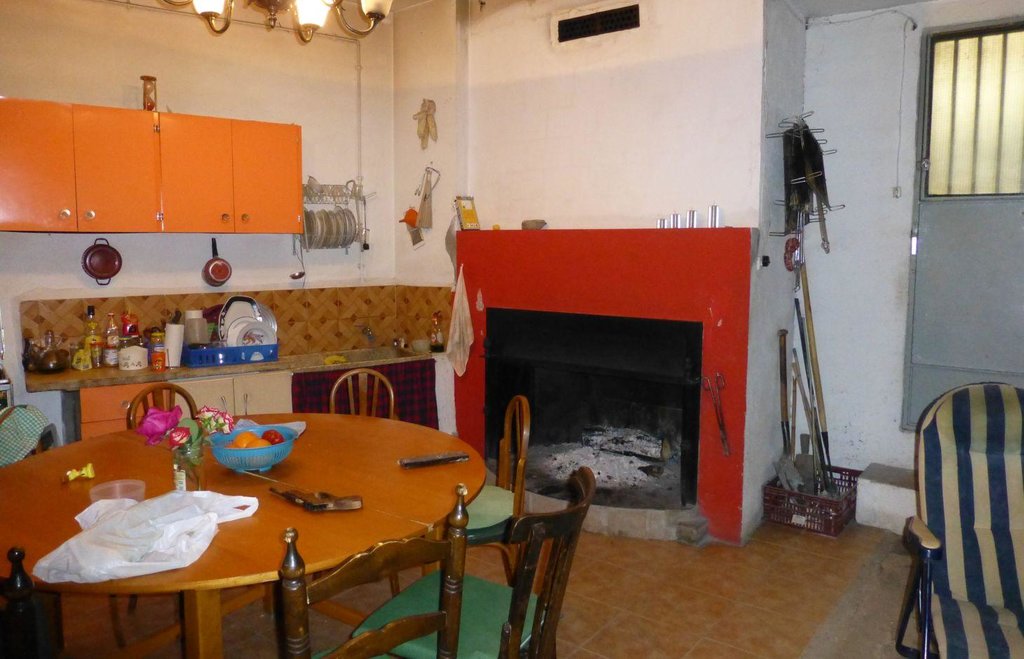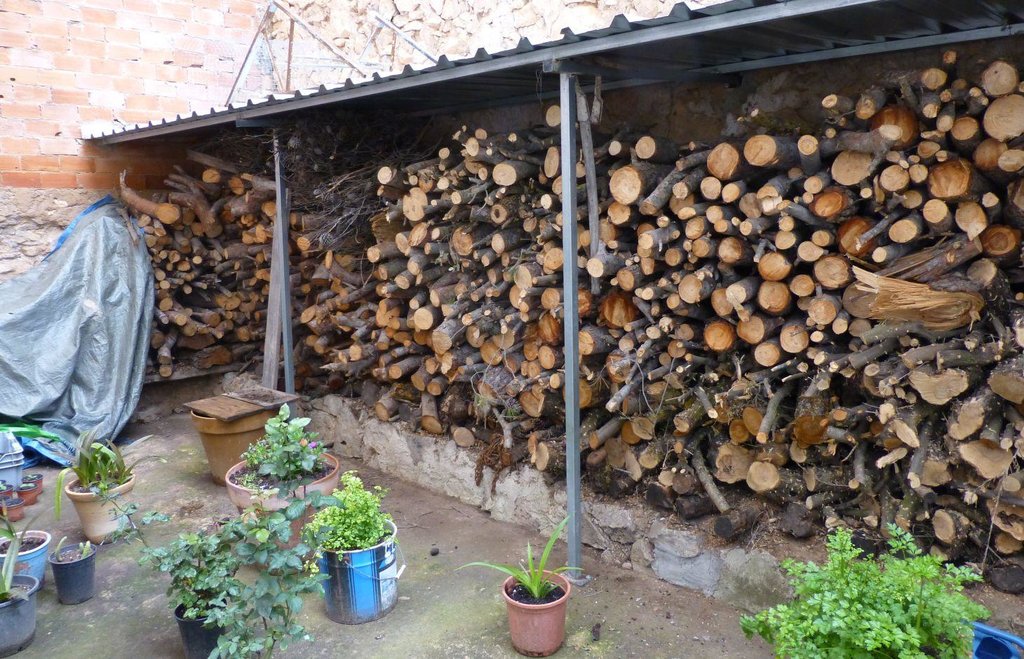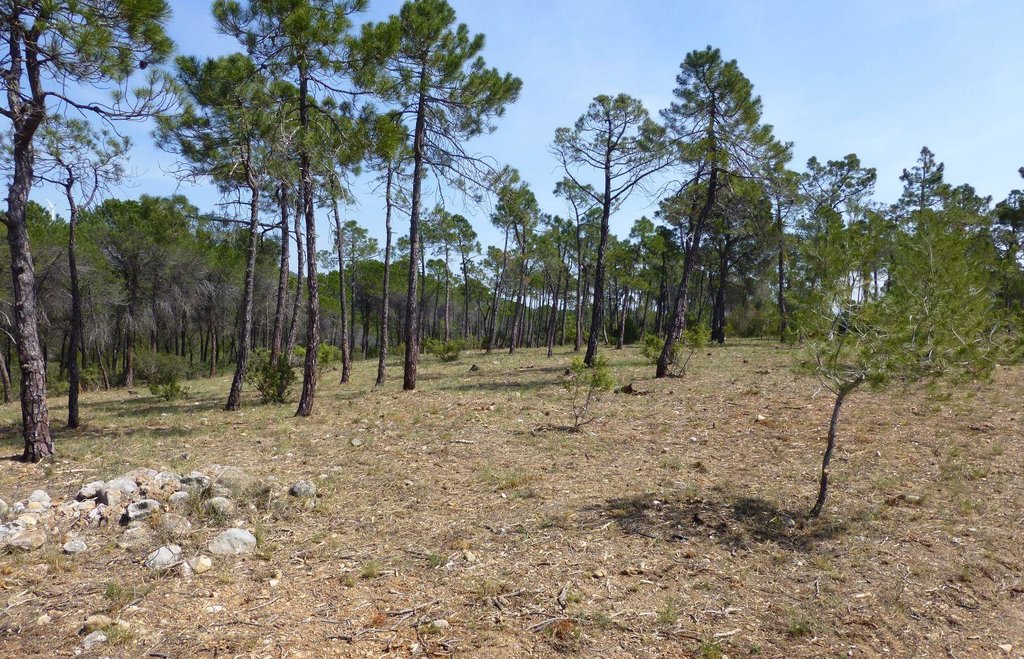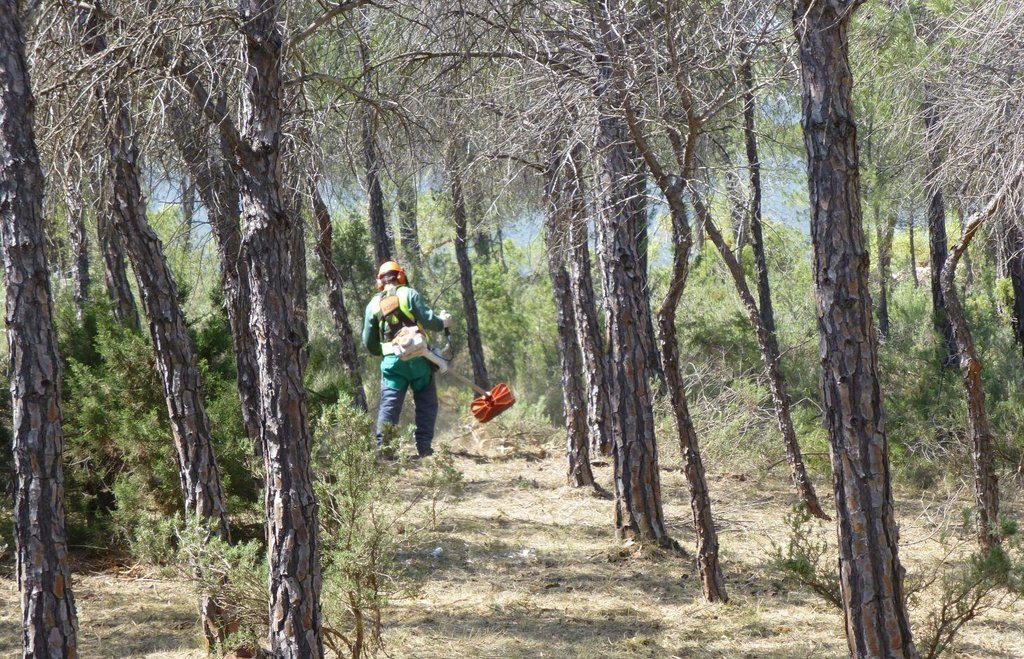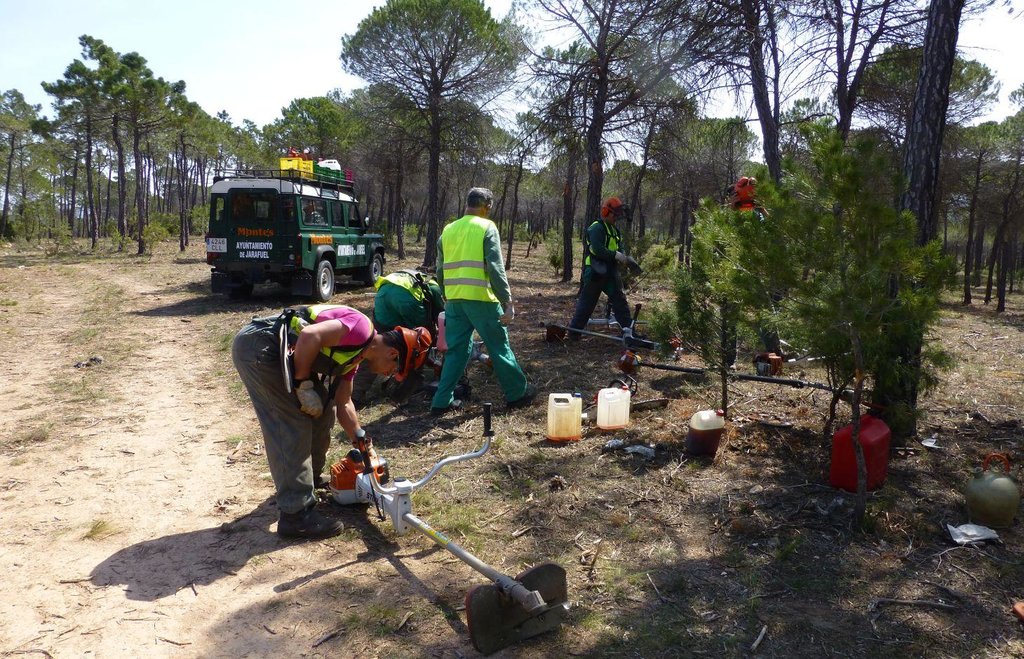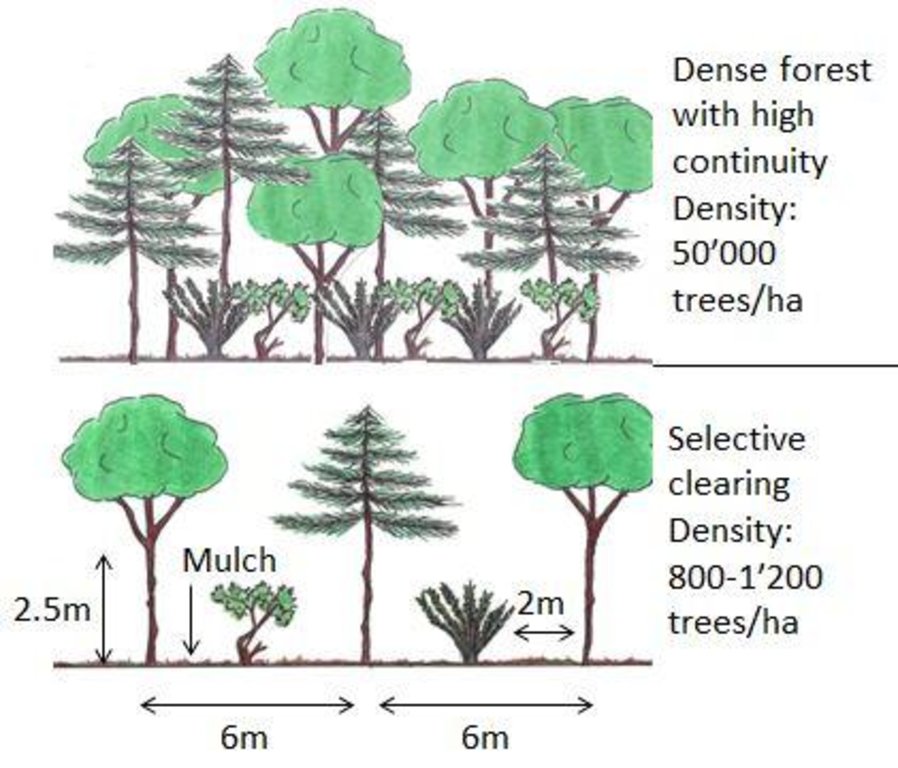Selective forest clearing to prevent large forest fires [西班牙]
- 创建:
- 更新:
- 编制者: Nina Lauterburg
- 编辑者: –
- 审查者: Deborah Niggli, Alexandra Gavilano
Clareo selectivo para la prevención de incendios (tratamientos selvícolas) (Spanish)
technologies_1586 - 西班牙
查看章节
全部展开 全部收起1. 一般信息
1.2 参与该技术评估和文件编制的资源人员和机构的联系方式
SLM专业人员:
Valdecantos Alejandro
Fundación Centro de Estudios Ambientales del Mediterráneo (CEAM)
西班牙
有助于对技术进行记录/评估的项目名称(如相关)
Catastrophic shifts in drylands (EU-CASCADE)有助于对技术进行记录/评估的机构名称(如相关)
Centro de Estudios Ambientales del Mediterraneo (CEAM) - 西班牙1.3 关于使用通过WOCAT记录的数据的条件
编制者和关键资源人员接受有关使用通过WOCAT记录数据的条件。:
是
1.4 所述技术的可持续性声明
这里所描述的技术在土地退化方面是否存在问题,导致无法被认为是一种可持续的土地管理技术?:
否
2. SLM技术的说明
2.1 技术简介
技术定义:
Selective forest clearing aims in reducing the connectivity and the amount of (dead standing) fuel, as well as reducing the competition between regenerating pines, in order to prevent forest fires and to ensure the growth of a healthy forest.
2.2 技术的详细说明
说明:
The forests in the Ayora region experienced a huge disturbance in the past, such as deforestations, removal of key species, land abandonment, dense growth of fire-prone seeder species (high continuity of dead standing fuel), missing management, wildfires and dense afforestations. These disturbances resulted in the degradation of the vegetation, the reduction of the resilience of the ecosystem against fires and thus an increasing risk of wildfires. After fires, many landscapes regenerated with a high and continuous fuel accumulation with few native resprouter species, which made it extremely difficult to control forest fires. The dense growth not only increased the risk of wildfires but also the competition between different species (nutrients, light, space). Therefore appropriate vegetation management to increase the resilience of the ecosystem to fires and to reduce competition is crucial.
These problems are approached by selective forest clearing. The main purposes of thinning dense pine forests are the prevention of fires by reducing the fuel load and its continuity, and to improve pine regeneration by eliminating the competition between different species. As a result, the quality of the plants is improved and the amount of dead or sick plants is reduced, which is essential to ensure a healthy forest. This also leads to a higher resistance to pests which in turn again decreases the risk of fire (less dead plants). Vegetation removal produces fresh vegetation growth, therefore more diverse and nutritious fodder is provided to animals (game and livestock) in the cleared areas which is a benefit for herders. Also wild animals use this fodder supply which in turn hinders them to destroy cultivated fields of the farmers. Furthermore, honey producers make use of the enhanced growth of shrubs and the additional space created by selective clearing to place their beehives and to increase honey production.
Especially during the current economic crisis forest management is an important source for jobs - most of the workers were unemployed before working in the selective clearing. Through the clearings, fuelwood is gained and offered to retired people for free for cooking and heating, allowing them to save money. Additionally, almost all villagers like to have a cleared forest due to its high aesthetic and recreational value.
In order to be selective and to preserve desired species, the clearing is done with small machines such as brushcutters and chainsaws. On average the forest is thinned until reaching a density of 800-1200 trees/ha. Species such as Juniperus, Rhamnus al., Quercus rotundifolia, Quercus faginea or Fraxinus ornus are not removed which increases the probability to have a more fire-resistant vegetation composition in future. Dead or sick plants and also a part of fire-prone shrubs such as Ulex parv. and Cistus alb. are removed. If there are both Pinus pinaster and Pinus halepensis. Pinus halepensis is cleared because they compete with each other. The roots are not removed which ensures the stability and productivity of the soil. The remaining species are pruned (“poda”) until a maximum height of 2.5m to improve the conditions of the species. Around each tree they should clear an area of 2m.
After felling trees and shrubs a part of the residues is chipped in-situ and covers the soil as mulch, which results in ecological benefits (e.g. increase in soil moisture, prevention from erosion, enhancement of nutrient cycling, reduction of the soil surface temperature).
If the slope is steep, it takes more time to do the clearing and it might also increase the risk of erosion afterwards. Under the best conditions (e.g. good access and terrain), 0.8ha per day are cleared (calculated for a group of 9 persons working 7 hours). In this case the costs are paid by the municipal council, which receives a part of the money from the rental fee paid by the wind mill company. The cleared areas have to be maintained depending on the speed of the vegetation growth (which amongst others depends on the soil, slope and humidity). If the clearings are done regularly, it takes less time and it is cheaper than the first clearing. It should be noted that recurrent maintenance is crucial to ensure the effectiveness of the technology.
The region of Ayora is mountainous with a dry subhumid climate (~380 mm annual rainfall). The risk of fire incidence is at its highest from June to September when there are adverse conditions like drought, high temperatures and strong winds (mainly the winds coming from central Spain, called “poniente”). The population density is very low and there are only few job opportunities (e.g. marginal agriculture, grazing, hunting, beekeeping). Most of the inhabitants work in the nuclear power plant. Forest management could be a source for jobs.
2.3 技术照片
2.5 已应用该技术的、本评估所涵盖的国家/地区/地点
国家:
西班牙
区域/州/省:
Spain, Valencia
有关地点的进一步说明:
Ayora/Jarafuel
具体说明该技术的分布:
- 均匀地分布在一个区域
如果不知道精确的区域,请注明大致覆盖的区域:
- 0.1-1 平方千米
注释:
Total area covered by the SLM Technology is 0.5 km2.
The forest agent told me that during this project they are clearing some 50 ha of forest. But in total (including the clearings in the past) they cleared more than 1000 ha in Jarafuel.
Map
×2.6 实施日期
如果不知道确切的年份,请说明大概的日期:
- 不到10年前(最近)
2.7 技术介绍
详细说明该技术是如何引入的:
- 通过项目/外部干预
注释(项目类型等):
The clearings documented here were done in the years 2012 and 2013, mandated by the state and executed by the municipal council of Jarafuel. But already in 1990 clearings (with machines) were applied. At that time they were called “ayuda regeneración” which means regeneration help.
3. SLM技术的分类
3.1 该技术的主要目的
- 降低灾害风险
3.2 应用该技术的当前土地利用类型

森林/林地
- (半天然)天然森林/林地
树木类型:
- 松属物种(松)
产品和服务:
- 木材
- 薪材
- 水果和坚果
- 其它森林产品
- 放牧/啃牧
- 自然保持/保护
- 娱乐/旅游
- 自然灾害防护
- wind mill parc, hunting
注释:
Major land use problems (compiler’s opinion): The prevalent dense shrublands (dominated by seeder species), which resulted from past agricultural land use (changes of the vegetation composition, e.g. removal of key species), land abandonment/rural depopulation and fire occurrence, contain a high fire risk because of both the high fuel loads and their continuity. Also dense forests (either afforestations or natural regeneration) show a high risk for fires. Through the modifications of the vegetation composition in the past (removal of more fire resistant resprouter species, whereas fire-prone seeder species are abundant), the resilience of the ecosystem to fires has decreased. Today a higher fire recurrence can be observed which could still be worsen by future climate change impacts, undermining more and more the ecosystem’s capacity to buffer such shocks. Furthermore, the high density of the forest results in a competition between different species which increases the amount of dead or thin material.
Selective felling of (semi-) natural forests: As a management practice. The forest should be cleared more frequently since there is a huge amount of fuel.
Plantation forestry: Almost the whole forest in this region was planted.
Trees/ shrubs species: Trees and shrubs are cleared (e.g. Ulex parviflorus, Cistus albidus, some pines)
Other species: Not removed species: e.g. Juniperus, Rhamnus alaternus, Quercus rotundifolia, Quercus faginea
3.3 由于技术的实施,土地使用是否发生了变化?
由于技术的实施,土地使用是否发生了变化?:
- 是(请在技术实施前填写以下有关土地利用的问题)
同一土地单元内混合使用的土地::
否

森林/林地
- (半天然)天然森林/林地
(半天然)天然森林/林地:具体说明管理类型:
- 选伐
3.5 该技术所属的SLM组
- 减少基于生态系统的灾害风险
3.6 包含该技术的可持续土地管理措施

植物措施
- V3:植被的清理
3.7 该技术强调的主要土地退化类型

生物性退化
- Bh:栖息地丧失
- Bf:火灾的有害影响
- Bs:质量和物种组成/多样性的下降
- Bp:害虫/疾病增加,捕食者减少
注释:
Main causes of degradation: deforestation / removal of natural vegetation (incl. forest fires) (Deforestation in the past (removal of resprouter species), land abandonment, uncontrolled growth of fire prone vegetation, afforestations, forest fires), population pressure (Vast areas were deforested in the past for agriculture, important key species were removed. After land abandonment there was a lack of management strategies.), poverty / wealth (The current economic crisis in Spain leads to a lack of investment in forest management, therefore only a minor part of forests is managed by selective clearing.), labour availability (In the past there was outmigration from the region to the big cities and therefore there was a lack of management.)
Secondary causes of degradation: change of seasonal rainfall (More variability in precipitation leads to a higher risk of fires.), droughts (more fires during droughts), land tenure (The state is only allowed to apply management practices in public forest. The private forest is often not managed which increases the risk of fires and the resulting degradation.), inputs and infrastructure: (roads, markets, distribution of water points, other, …) (There were big fires in the past because of the lack of fire extinction media like water ponds, streets, transport media (this has been improved now).), education, access to knowledge and support services (Loss of knowledge, important for today’s fires: People (especially from the cities) are not aware anymore of the risk of fire. In the past people lived with the risk and knew how to prevent fires.), governance / institutional (Law to induce implementation of conservation interventions (ley forestal 3/1993) and “plan de selvicultura preventiva de incendios en los sistemas forestales de Valencia (1996)”. Before less practices)
3.8 防止、减少或恢复土地退化
具体数量名该技术与土地退化有关的目标:
- 防止土地退化
- 减少土地退化
4. 技术规范、实施活动、投入和成本
4.1 该技术的技术图纸
技术规范(与技术图纸相关):
The main purposes of thinning dense forests (some 50’000 individuals per ha) are the prevention of fires by reducing the fuel load and its continuity (both vertical and horizontal), and to improve regeneration by eliminating the competition between different species. On average the forest is thinned until reaching a density of 800-1200 trees/ha. Species such as Juniperus, Rhamnus al., Quercus rotundifolia, Quercus faginea or Fraxinus ornus are not removed which increases the probability to have a more fire-resistant vegetation composition in future. Dead or sick plants and also a part of fire-prone shrubs such as Ulex parv. and Cistus alb. are removed.
The remaining species are pruned (“poda”) until a maximum height of 2.5m to improve the conditions of the species. Around each tree they should clear an area of at least 2m but ideally there should be a distance of 6m between different individuals.
After felling trees and shrubs a part of the residues is chipped in-situ and covers the soil as mulch, which results in ecological benefits and provides fodder to livestock and game.
Location: Ayora/Jarafuel. Valencia, Spain
Date: 08-12-2013
Technical knowledge required for field staff / advisors: high (The forest agent needs a high technical knowledge. He acts as a link between engineer and forest brigade and controls if the brigade executes what the engineer dictates. He also provides assistance.)
Technical knowledge required for forest engineer: high (The forest engineer works for the state and plans the clearing project, therefore he needs a high technical knowledge.)
Technical knowledge required for forest workers/brigade: low (The forest workers only execute what the engineer and the forest agent tell them. They need to know how to handle the machines but don’t have to judge which trees and shrubs need to be cleared.)
Main technical functions: control of fires, reduction of dry material (fuel for wildfires), reduction of fire-prone species
Secondary technical functions: control of raindrop splash, increase in nutrient availability (supply, recycling,…), increase / maintain water stored in soil, promotion of vegetation species and varieties (quality, eg palatable fodder)
Vegetative measure: selective vegetation clearing
Vegetative material: T : trees / shrubs
Trees/ shrubs species: Trees and shrubs are cleared (e.g. Ulex parviflorus, Cistus albidus, some pines)
Other species: Not removed species: e.g. Juniperus, Rhamnus alaternus, Quercus rotundifolia, Quercus faginea,
作者:
Nina Lauterburg
4.2 有关投入和成本计算的一般信息
其它/国家货币(具体说明):
Euro
如相关,注明美元与当地货币的汇率(例如1美元=79.9巴西雷亚尔):1美元=:
0.74
注明雇用劳工的每日平均工资成本:
47.00
4.3 技术建立活动
| 活动 | 时间(季度) | |
|---|---|---|
| 1. | Cutting and chipping (in-situ) of trees and shrubs (selective clearing) | autumn/winter, in this case late spring (end of may) |
| 2. | Transport of wood (fuel wood) | after clearing |
4.4 技术建立所需要的费用和投入
| 对投入进行具体说明 | 单位 | 数量 | 单位成本 | 每项投入的总成本 | 土地使用者承担的成本% | |
|---|---|---|---|---|---|---|
| 劳动力 | labour | ha | 1.0 | 404.0 | 404.0 | |
| 设备 | machine use | ha | 1.0 | 2024.0 | 2024.0 | |
| 技术建立所需总成本 | 2428.0 | |||||
| 技术建立总成本,美元 | 3281.08 | |||||
4.5 维护/经常性活动
| 活动 | 时间/频率 | |
|---|---|---|
| 1. | Cutting and chipping (in-situ) of trees and shrubs (selective clearing) | autumn/winter, in this case late spring (end of may) |
| 2. | Transport of wood (fuelwood) | after clearing |
4.6 维护/经常性活动所需要的费用和投入(每年)
| 对投入进行具体说明 | 单位 | 数量 | 单位成本 | 每项投入的总成本 | 土地使用者承担的成本% | |
|---|---|---|---|---|---|---|
| 设备 | machine use | ha | 1.0 | 446.0 | 446.0 | |
| 技术维护所需总成本 | 446.0 | |||||
| 技术维护总成本,美元 | 602.7 | |||||
注释:
Machinery/ tools: brushcutters, chainsaws, tractors
The costs were calculated for the application of the technology (selective clearing) on one hectare. In this case, 9 people are working as a team. If the site is accessible and if the terrain is good for clearing work they can clear 0.8 ha per day. It should be noted that clearing with small machines such as brushcutters and chainsaws is much more expensive than clearing with tractors, but often it is only possible to clear with small machines (e.g. removal of trees is not possible with tractors). A tractor costs more or less 500 Euro per ha (674 Dollar per ha). A clearing of a pine forest with manual machines costs around 1800 Euro per ha (2428 Dollar per ha). The costs of the maintenance activities (e.g. second clearing) are much lower because the area was cleared already some years before. Therefore more ha per day can be cleared.
In Jarafuel, a part of the costs are covered by the rental fee paid by the windmill company.
The currency rate (Euro-Dollar) was calculated on November 16th, 2013.
4.7 影响成本的最重要因素
描述影响成本的最决定性因素:
The costs of selective forest clearing can be affected by numerous factors, such as slope (if the slope is steep, the work is much more difficult and takes more time), vegetation density (it takes more time to clear a dense area) and vegetation type (pine forest or shrubland), distance from a street (people can work less in a day if they have to walk far to clear). Important to note is that maintenance costs could increase with an increase in rainfall because the vegetation will grow faster.
5. 自然和人文环境
5.1 气候
年降雨量
- < 250毫米
- 251-500毫米
- 501-750毫米
- 751-1,000毫米
- 1,001-1,500毫米
- 1,501-2,000毫米
- 2,001-3,000毫米
- 3,001-4,000毫米
- > 4,000毫米
有关降雨的规范/注释:
Ayora, Jarafuel (Ayora: 383mm)
农业气候带
- 半湿润
Thermal climate class: temperate
5.2 地形
平均坡度:
- 水平(0-2%)
- 缓降(3-5%)
- 平缓(6-10%)
- 滚坡(11-15%)
- 崎岖(16-30%)
- 陡峭(31-60%)
- 非常陡峭(>60%)
地形:
- 高原/平原
- 山脊
- 山坡
- 山地斜坡
- 麓坡
- 谷底
垂直分布带:
- 0-100 m a.s.l.
- 101-500 m a.s.l.
- 501-1,000 m a.s.l.
- 1,001-1,500 m a.s.l.
- 1,501-2,000 m a.s.l.
- 2,001-2,500 m a.s.l.
- 2,501-3,000 m a.s.l.
- 3,001-4,000 m a.s.l.
- > 4,000 m a.s.l.
5.3 土壤
平均土层深度:
- 非常浅(0-20厘米)
- 浅(21-50厘米)
- 中等深度(51-80厘米)
- 深(81-120厘米)
- 非常深(> 120厘米)
土壤质地(表土):
- 细粒/重质(粘土)
表土有机质:
- 中(1-3%)
5.4 水资源可用性和质量
地下水位表:
> 50米
地表水的可用性:
匮乏/没有
水质(未处理):
良好饮用水
5.5 生物多样性
物种多样性:
- 中等
5.6 应用该技术的土地使用者的特征
生产系统的市场定位:
- 混合(生计/商业)
个人或集体:
- 员工(公司、政府)
性别:
- 男人
说明土地使用者的其他有关特征:
Land users applying the Technology are mainly common / average land users
Difference in the involvement of women and men: Yes, the work is mainly done by men, because it is heavy work and it is not usual that women are working in the forest.
Population density: < 10 persons/km2
Annual population growth: negative
Off-farm income specification: The forest brigade is only working when there is money and a project. If there is no money they have no work and need to look for another job.
5.8 土地所有权、土地使用权和水使用权
土地所有权:
- 州
- 个人,有命名
土地使用权:
- 个人
- public/open access but organised (e.g. wood, hunting)
- public/open access but organised (e.g. wood, hunting)
注释:
There is some public land, controlled by the state. But there is also some private land. The access to the public land is open but organized. Permission is needed from the government to cut trees, to build a house or to hunt. There are some private hunting areas for which the hunting association has to pay a fee.
6. 影响和结论性说明
6.1 该技术的现场影响
社会经济效应
生产
饲料生产
注释/具体说明:
Vegetation removal produces fresh growth. More grasses available for animals (game and livestock) in the cleared areas.
饲料质量
注释/具体说明:
The new growth provides more diverse and nutritious fodder Animals (especially goats) eat everything but they like more young grasses than shrubs
畜牧生产
注释/具体说明:
Game/wildlife and livestock are better because there is an increase in fodder quantity and quality
木材生产
注释/具体说明:
Production increases because there is less competition between species (nutrients,light,space). The wood/timber generated by the clearing can be used for biomass, fertilizers, pellets, firewood. A part of the wood is chipped in-situ and applied as mulch.
产品多样性
注释/具体说明:
Honey (bees can fly better), hunting, wood/timber
生产区域
注释/具体说明:
There are more opportunities to place the beehives
能源生产
注释/具体说明:
A part of the cleared vegetation is used for bioenergy (biomass).
收入和成本
农业投入费用
注释/具体说明:
Less damage on the cultivated fields because the wild animals do not destroy the fields anymore and stay in the forest (because there is more grass available due to clearings).
农业收入
注释/具体说明:
A cleared forest has a higher value–e.g. a “finca” with an exclusive right for hunting earns more because there are more animals (more fodder), or because it is easier to shoot animals (less possibilities to hide). Each killed animal has to be paid.
工作量
注释/具体说明:
The establishment and the maintenance is expensive because the work has to be done manually (manual machines)
其它社会经济效应
fuelwood
注释/具体说明:
Villagers of Jarafuel receive fuelwood gained by clearings for free (from municipal council).
job uncertainty
注释/具体说明:
If there is no money provided by the state the clearings cannot be executed. This constitutes a high risk for forest workers because they never know if they will loose their jobs
社会文化影响
食品安全/自给自足
注释/具体说明:
Forest workers earn money to buy food, otherwise they would depend on unemployment pay and thus put pressure on the state.
健康状况
注释/具体说明:
Improved air quality by reducing forest fires
文化机会
注释/具体说明:
People appreciate the visual impact of a cleared forest. It has a high aesthetic value and offers recreational opportunities.
娱乐机会
注释/具体说明:
People appreciate the visual impact of a cleared forest. It has a high aesthetic value and offers recreational opportunities.
SLM/土地退化知识
注释/具体说明:
Local people know about the importance of conservation of the area and really like to have the forest protected of wildfires
冲突缓解
注释/具体说明:
Less fires result in a decrease of the destroyed area, less money will have to be invested in restoration or fire extinction. Farmers, hunters,honey producers will experience fewer losses. Wild animals remain in the forest (more grasses after clearing).
社会经济弱势群体的情况
注释/具体说明:
More jobs for unemployed, this is especially important during the current economic crisis
contribution to human well-being
注释/具体说明:
Through the clearings it is easier to control fires and protect people. Furthermore it created jobs for the unemployed. In general forest management is not something people want to do, they work in this sector only if there are no other job opportunities. Forest management means a hard job and this kind of work is not well-respected in society.
生态影响
水循环/径流
蒸发
注释/具体说明:
Due to the mulch layer more moisture is stored in the soil and less water is lost by evaporation (the soil is covered)
土壤
土壤水分
注释/具体说明:
More soil moisture because of less dense forest/shrubland and mulch cover after clearing
土壤覆盖层
注释/具体说明:
Mulch layer
土壤结壳/密封
注释/具体说明:
Mulch layer protects the soil from crusting
养分循环/补给
土壤有机物/地下C
生物多样性:植被、动物
生物量/地上C
植物多样性
注释/具体说明:
By clearing the competition between species is reduced but the forest agent told me that there are not more species, the same species grow again. But maybe there is more space for dispersal of seeds by birds.
动物多样性
注释/具体说明:
There might be more animals because of the fodder supply
害虫/疾病控制
注释/具体说明:
Mono-plantations are bad for the propagation of a pest. After clearing there is a decrease in competition, plants are in healthier conditions,less prone to diseases.Weak plants are eliminated which reduces the risk of pests (always weak plants affected)
减少气候和灾害风险
碳和温室气体的排放
注释/具体说明:
less emissions because there is less burnt vegetation
火灾风险
注释/具体说明:
By clearing the forest the vertical and horizontal connectivity of the vegetation is interrupted and the amount of fuel is reduced.
6.2 该技术的场外影响已经显现
下游洪水
注释/具体说明:
When fire removes less vegetation then the soil is less prone to flooding
下游淤积
注释/具体说明:
When fire removes less vegetation then the soil is less vulnerable to erosion
对公共/私人基础设施的破坏
注释/具体说明:
Forest fire frequency and intensity and the associated damages are reduced
6.3 技术对渐变气候以及与气候相关的极端情况/灾害的暴露和敏感性(土地使用者认为的极端情况/灾害)
渐变气候
渐变气候
| 季节 | 增加或减少 | 该技术是如何应对的? | |
|---|---|---|---|
| 年温度 | 增加 | 好 |
气候有关的极端情况(灾害)
气象灾害
| 该技术是如何应对的? | |
|---|---|
| 局地暴雨 | 好 |
| 局地风暴 | 好 |
气候灾害
| 该技术是如何应对的? | |
|---|---|
| 干旱 | 好 |
水文灾害
| 该技术是如何应对的? | |
|---|---|
| 比较和缓的(河道)洪水 | 好 |
其他气候相关的后果
其他气候相关的后果
| 该技术是如何应对的? | |
|---|---|
| 缩短生长期 | 未知 |
注释:
The technology was not modified but it is important to add some notes to the above stated reactions to climatic extremes. The cleared areas are quite resistant against climate change or weather extremes. Only if there will be more rainfall the vegetation might grow faster and the maintenance costs could increase.
6.4 成本效益分析
技术收益与技术建立成本相比如何(从土地使用者的角度看)?
短期回报:
非常积极
长期回报:
非常积极
技术收益与技术维护成本/经常性成本相比如何(从土地使用者的角度看)?
短期回报:
非常积极
长期回报:
非常积极
注释:
Both the short-term and the long-term benefits are very positive assuming that maintenance is done. It contributes to prevent devastating fires and to guarantee a healthy forest. Together with the creation of jobs, directly after clearing there is firewood and timber available and a reduced risk of wildfires. But it should also be considered that the establishment costs are high. If maintenance is not done the long-term returns will be very negative because an increase in the risk of fire will occur again (without management, there will also be no firewood, no timber and no jobs). The maintenance costs increase the longer you wait because the vegetation will grow again densely.
6.5 技术采用
注释:
Comments on acceptance with external material support: The clearing is financed by the state (indirectly the clearings are partly paid by the local wind mill company through their rental fee).
There is no trend towards spontaneous adoption of the Technology
Clearings are only done when the state has money. Selective clearing is also applied in other countries/regions, e.g. in California.
6.7 该技术的优点/长处/机会
| 土地使用者眼中的长处/优势/机会 |
|---|
| There are both social and economic benefits for local people. The selective clearings provide jobs for rural people, which allows them to increase their livelihood conditions. People do not depend on unemployment pays and are therefore more accepted in society. A part of the extracted wood is used for biomass, fertilizers, pellets, or firewood. Furthermore there would be improved conditions for grazing. Therefore forest management contributes to rural development. |
| There are also off-site benefits. Fewer fires will result in a reduction of downstream flooding, downstream siltation and damage on neighbours’ fields. When fire removes less vegetation the soil is less vulnerable to erosion. |
| In Jarafuel where most of the land is public retired people receive the firewood gained by forest clearings for free. They can use the wood for cooking and heating and save a lot of money. |
| Almost all villagers like to see a cleared forest. It has a high aesthetic and recreational value (it is possible to walk through the forest). They are also aware that the risk of wildfires is reduced through this technology. |
| Shepherds, hunters and farmers benefit from forest clearings. Vegetation removal produces fresh vegetation growth, therefore more diverse and nutritious fodder is available for animals (game and livestock) in the cleared areas. Game/wildlife and livestock are better because there is an increase in fodder quantity and quality. Wild animals benefit from this food source which in turn hinders them to destroy cultivated fields of the farmers. Also honey producers benefit from the cleared areas since bees can fly better and there is more place to put the beehives, furthermore the growth of shrubs is enhanced. |
| 编制者或其他关键资源人员认为的长处/优势/机会 |
|---|
| Through selective forest clearing the fuel amount and connectivity (vertical/horizontal) is reduced which is crucial for preventing the occurrence and spread of large forest fires. |
| There is a reduction of competition between plants which is essential to ensure a healthy forest (more nutrients, light, space). This also leads to a higher resistance against pests which in turn again decreases the fire risk (less dead or sick plants). |
| Fuel management through vegetation clearing presents some positive aspects with respect to other techniques, e.g. the possibility of being selective in order to preserve desired species or individuals. Furthermore, after felling trees and shrubs a part of the vegetation is chipped in-situ and covers the soil as mulch. This results in ecological benefits (e.g. increase in soil moisture, prevention from erosion, enhancement of nutrient cycling, reduction of the soil surface temperature and evaporation loss). |
| The trees/shrubs are cut but the roots are not removed. This ensures the stability and productivity of the soil. |
| Fewer fires result in a decrease of the destroyed area, less money will have to be invested in restoration or fire extinction. Furthermore, farmers, hunters and honey producers will experience fewer losses. |
6.8 技术的弱点/缺点/风险及其克服方法
| 编制者或其他关键资源人员认为的弱点/缺点/风险 | 如何克服它们? |
|---|---|
| The establishment and the maintenance activities are expensive and labour-intensive. Without management the technology is not effective anymore. It would be necessary to extract biomass from the forest to decrease the continuity of the trees and shrubs. In case of a lack of management the risk of fires increases. | Management is crucial. Prevention measures are often less expensive than rehabilitation activities after a fire. The state should therefore invest more money in forest management and fire prevention. Managing the forest would not only decrease the risk of fire but also generate benefits (e.g. wood, biomass, fuelwood). Instead of getting unemployment pay people could get jobs in forest management. Stakeholders mentioned that it would be important to promote the forest as a sustainable economic resource and that the relation between the villagers and the forest should be enhanced. Furthermore it was mentioned that traditional activities (such as grazing, agriculture, wood gathering) should be reactivated and that the villagers should get economic compensation to maintain the forest in a good state. Especially the promotion of grazing was stressed many times. Also planting of more fire-resistant species (late successional stages) in some spots as suggested by CEAM could increase the resilience of the ecosystem and decrease management costs. |
| The clearing of forests has potential to prevent fires and therefore degradation. But there are also a lot of highly connected shrublands with a high fuel load which are not addressed by this management practice. | Shrublands need to be cleared as well since they constitute a huge risk for wildfires. |
| If there is more space after clearing the first shrubs which will grow will be fire-prone early successional species, such as Cistus albidus and Ulex parviflorus. Without management, they will increase the risk of fires. | Recurrent maintenance is crucial to ensure the effectiveness of the technology. Management through grazing could be a simple way to reduce the costs and the risk. By planting resprouter species really densely seeders would not grow anymore in those spots which would also decrease the fire risk and the management costs. |
| When the clearing is done on extremely steep slopes there might be an increase in erosion. | Before clearing the soil erosion risk should be calculated. |
| In some areas there will be less shade which could harm some species. |
7. 参考和链接
7.1 信息的方法/来源
- 实地考察、实地调查
- 与土地使用者的访谈
(现场)数据是什么时候汇编的?:
11/05/2013
链接和模块
全部展开 全部收起链接
无链接
模块
无模块


